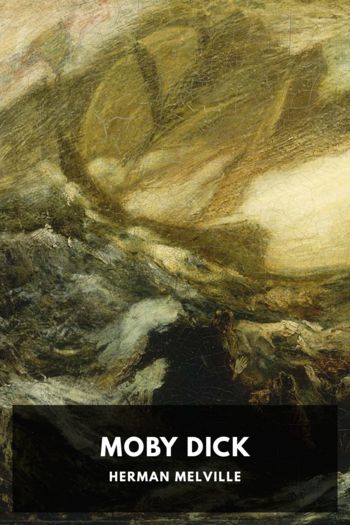Moby Dick Herman Melville (polar express read aloud TXT) 📖

- Author: Herman Melville
Book online «Moby Dick Herman Melville (polar express read aloud TXT) 📖». Author Herman Melville
There are only two books in being which at all pretend to put the living sperm whale before you, and at the same time, in the remotest degree succeed in the attempt. Those books are Beale’s and Bennett’s; both in their time surgeons to English South-Sea whale-ships, and both exact and reliable men. The original matter touching the sperm whale to be found in their volumes is necessarily small; but so far as it goes, it is of excellent quality, though mostly confined to scientific description. As yet, however, the sperm whale, scientific or poetic, lives not complete in any literature. Far above all other hunted whales, his is an unwritten life.
Now the various species of whales need some sort of popular comprehensive classification, if only an easy outline one for the present, hereafter to be filled in all its departments by subsequent laborers. As no better man advances to take this matter in hand, I hereupon offer my own poor endeavors. I promise nothing complete; because any human thing supposed to be complete, must for that very reason infallibly be faulty. I shall not pretend to a minute anatomical description of the various species, or—in this place at least—to much of any description. My object here is simply to project the draught of a systematization of cetology. I am the architect, not the builder.
But it is a ponderous task; no ordinary letter-sorter in the Post-Office is equal to it. To grope down into the bottom of the sea after them; to have one’s hands among the unspeakable foundations, ribs, and very pelvis of the world; this is a fearful thing. What am I that I should essay to hook the nose of this leviathan! The awful tauntings in Job might well appal me. “Will he (the leviathan) make a covenant with thee? Behold the hope of him is vain!” But I have swam through libraries and sailed through oceans; I have had to do with whales with these visible hands; I am in earnest; and I will try. There are some preliminaries to settle.
First: The uncertain, unsettled condition of this science of Cetology is in the very vestibule attested by the fact, that in some quarters it still remains a moot point whether a whale be a fish. In his System of Nature, AD 1776, Linnaeus declares, “I hereby separate the whales from the fish.” But of my own knowledge, I know that down to the year 1850, sharks and shad, alewives and herring, against Linnaeus’s express edict, were still found dividing the possession of the same seas with the Leviathan.
The grounds upon which Linnaeus would fain have banished the whales from the waters, he states as follows: “On account of their warm bilocular heart, their lungs, their movable eyelids, their hollow ears, penem intrantem feminam mammis lactantem,” and finally, “ex lege naturae jure meritoque.” I submitted all this to my friends Simeon Macey and Charley Coffin, of Nantucket, both messmates of mine in a certain voyage, and they united in the opinion that the reasons set forth were altogether insufficient. Charley profanely hinted they were humbug.
Be it known that, waiving all argument, I take the good old fashioned ground that the whale is a fish, and call upon holy Jonah to back me. This fundamental thing settled, the next point is, in what internal respect does the whale differ from other fish. Above, Linnaeus has given you those items. But in brief, they are these: lungs and warm blood; whereas, all other fish are lungless and cold blooded.
Next: how shall we define the whale, by his obvious externals, so as conspicuously to label him for all time to come? To be short, then, a whale is a spouting fish with a horizontal tail. There you have him. However contracted, that definition is the result of expanded meditation. A walrus spouts much like a whale, but the walrus is not a fish, because he is amphibious. But the last term of the definition is still more cogent, as coupled with the first. Almost anyone must have noticed that all the fish familiar to landsmen have not a flat, but a vertical, or up-and-down tail. Whereas, among spouting fish the tail, though it may be similarly shaped, invariably assumes a horizontal position.
By the above definition of what a whale is, I do by no means exclude from the leviathanic brotherhood any sea creature hitherto identified with the whale by the best informed Nantucketers; nor, on the other hand, link with it any fish hitherto authoritatively regarded as alien.2 Hence, all the smaller, spouting, and horizontal tailed fish must be included in this ground-plan of Cetology. Now, then, come the grand divisions of the entire whale host.
First: According to magnitude I divide the whales into three primary books (subdivisible into chapters), and these shall comprehend them all, both small and large.
I, the Folio Whale; II, the Octavo Whale; III, the Duodecimo Whale.
As the type of the Folio I present the “Sperm Whale”; of the Octavo, the “Grampus”; of the Duodecimo, the “Porpoise.”
Folios. Among these I here include the following chapters:—I, The “Sperm Whale”; II, the “Right Whale”; III, the “Finback Whale”; IV, the “Humpbacked Whale”; V, the “Razor Back Whale”; VI, the “Sulphur Bottom Whale.”
Book I (“Folio”), chapter I (“Sperm Whale”).—This whale, among the English of old vaguely known as the Trumpa whale, and the Physeter whale, and the Anvil Headed whale, is the present Cachalot of the French, and the Pottsfich of the Germans, and the Macrocephalus of the Long Words. He is, without doubt, the largest inhabitant of the globe; the most formidable of all whales to encounter; the most majestic in aspect; and





Comments (0)